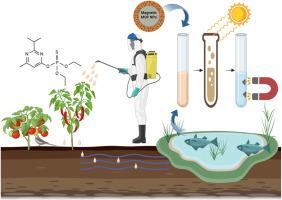mof集成磁性纳米材料用于水系统中农药残留废物的可持续去除
IF 2.4
4区 物理与天体物理
Q3 PHYSICS, CONDENSED MATTER
引用次数: 0
摘要
水的污染已经成为对世界的一个重大威胁。近年来,农业在满足健康和生活需求方面取得了巨大进步;然而,向水中排放微量农药会对人类和环境健康造成不利影响。因此,本文综述了金属有机骨架磁性纳米颗粒的制备和应用,以有效去除水中农药的最新进展。由金属离子和多齿有机配体组成的多孔无机-有机杂化网络被称为金属-有机框架(mof),是一种有趣的结构。磁性纳米颗粒与金属有机骨架(mof)的可控集成是新型多功能磁性mof基材料的发展方向。与单独的组件相比,这些材料显示出更高的效率。这些材料的大表面积、可延展性孔径和磁性可分离性赋予了它们独特的结构特征和现实意义。吸附和光催化降解具有双重功能。此外,这些过程协同工作,对各种污染物实现非常高的去除率。除了讨论提高MOF-MNCs速度的可能方法外,它还解决了现代对稳定性和可扩展性的关注。本文综述了近年来基于mof的磁性异质结构材料在去除有害环境污染物方面的研究进展。还包括所有已知的合成磁性mof的有效方法的综合列表。因此,未来将进一步探索MOF-MNCs作为一种实用高效的水污染解决方案的潜力,以加强其在该领域的应用。最后,我们概述了我们对磁性MOF材料在未来污染控制中的发展和面临的障碍的期望。本文章由计算机程序翻译,如有差异,请以英文原文为准。

MOF-integrated magnetic nanomaterials for sustainable removal of pesticide residue wastes in aqueous systems
Contamination of water has become a significant threat to the world. The agricultural industry has made enormous improvements in meeting health and life demands in recent years; nonetheless, the discharge of tiny doses of pesticides into water can cause adverse effects on both human and environmental health. Therefore, recent advances in the creation and application of magnetic nanoparticles derived from metal-organic frameworks (MOFs) for the effective removal of pesticides from water are highlighted in this review article. Porous inorganic-organic hybrid networks made of metal ions and multidentate organic ligands are known as metal-organic frameworks (MOFs), and they are interesting. Innovative multifunctional magnetic MOF-based materials are being developed by the controlled integration of magnetic nanoparticles with metal-organic frameworks (MOFs). These materials show enhanced efficiency compared to the separate components. These materials' large surface area, malleable pore size, and magnetic separability gave them unique structural characteristics and real-world implications. Adsorption and photocatalytic degradation are shown to have dual functionality in this work. Additionally, these processes work together to achieve very high removal rates for a wide range of pollutants. In addition to discussing possible ways to improve the speed of MOF-MNCs, it also addresses modern concerns about stability and scalability. This research summarises the recent noteworthy advancements in developing magnetic heterostructure materials based on MOFs for the removal of harmful environmental contaminants. Also included is a comprehensive list of all known effective methods for synthesizing magnetic MOFs. Consequently, the potential of MOF-MNCs as a practical and efficient solution to water contamination will be further explored in the future to enhance their application in this field. We conclude by outlining our expectations for the development and obstacles faced by magnetic MOF materials in the future of pollution control.
求助全文
通过发布文献求助,成功后即可免费获取论文全文。
去求助
来源期刊

Solid State Communications
物理-物理:凝聚态物理
CiteScore
3.40
自引率
4.80%
发文量
287
审稿时长
51 days
期刊介绍:
Solid State Communications is an international medium for the publication of short communications and original research articles on significant developments in condensed matter science, giving scientists immediate access to important, recently completed work. The journal publishes original experimental and theoretical research on the physical and chemical properties of solids and other condensed systems and also on their preparation. The submission of manuscripts reporting research on the basic physics of materials science and devices, as well as of state-of-the-art microstructures and nanostructures, is encouraged.
A coherent quantitative treatment emphasizing new physics is expected rather than a simple accumulation of experimental data. Consistent with these aims, the short communications should be kept concise and short, usually not longer than six printed pages. The number of figures and tables should also be kept to a minimum. Solid State Communications now also welcomes original research articles without length restrictions.
The Fast-Track section of Solid State Communications is the venue for very rapid publication of short communications on significant developments in condensed matter science. The goal is to offer the broad condensed matter community quick and immediate access to publish recently completed papers in research areas that are rapidly evolving and in which there are developments with great potential impact.
 求助内容:
求助内容: 应助结果提醒方式:
应助结果提醒方式:


